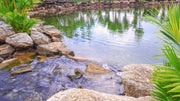
Why Beneficial Bacteria Need More Than Muck to Keep Water Crystal-Clear
Introduction: The Hidden Workforce in Every Pond
Glance into any healthy garden pond and you’ll see fish, plants, maybe a Poposoap solar fountain pushing silver spray across the surface. What you don’t see—the trillions of beneficial bacteria coating every pebble—does most of the cleaning. These microbes digest toxic ammonia, break down mulm, and out-compete algae for nutrients. Some keepers therefore wonder: “If bacteria already live in the silt trapped between my rocks, do I really need filters, bottled cultures, or extra gear?” This article answers that question with science, field experience, and a few solar-powered tricks inspired by Poposoap’s “hassle-free water garden” philosophy.
Can Silt Between Rocks Hold Enough Bacteria?

Yes—up to a point. The thin brown film on stones and the soft dust that gathers in crevices teem with nitrifiers. In a lightly stocked wildlife pond, that natural bio-film can convert most fish waste. But three hard limits appear the moment you add koi, goldfish, or a higher feed load:
- Oxygen penetration – Silt compacts; below a few millimetres it turns anoxic, breeding hydrogen-sulfide producers that release rotten-egg gas instead of cleaning the water.
- Surface area – A single cubic metre of pea gravel offers about 100 m² of space. A midsize koi needs several times that just to process its daily ammonia output.
- Flow – Bacteria only work when water—and oxygen—reach them. Pockets behind boulders trap debris but provide little circulation.
Result: rock silt helps, yet can’t shoulder the biological load in an ornamental pond on its own.
Factors That Influence Bacteria Colonization

- Water temperature – Activity doubles between 10 °C and 20 °C, then slows again beyond 28 °C.
- Carbonate hardness (KH) – Below 50 ppm, acids from nitrification crash pH and stall bacterial growth.
- Dissolved oxygen – Nitrifiers need ≥ 6 mg L-¹; stagnant corners seldom reach that.
- Flow rate – Aim to circulate the entire pond volume every one to two hours through active media. Poposoap Solar Pond Filters move 80–680 GPH without a single watt from the grid, keeping water in constant contact with oxygenated pads.
- Surface texture – Pitted lava rock, bio-balls, and purpose-made foam cubes dwarf the surface area of smooth landscaping gravel.
Common Misconceptions About “Natural Balance”

Myth 1: Clear water means balanced bacteria.
Crystal clarity can hide rising ammonia; only test kits reveal the truth.
Myth 2: Thick sludge is your friend.
A light dusting of mulm is beneficial; centimetres of black muck consume oxygen and smother good bacteria.
Myth 3: Bottled cultures are snake oil.
Lab studies show seeded Nitrosomonas colonies establish days to weeks faster than waiting for airborne spores—critical after medicating fish or scrubbing filters.
When & Why to Add Beneficial Bacteria Products

- New pond start-ups – Jump-start filters so koi can move in sooner.
- After heavy clean-outs – Replace colonies lost to chlorinated tap water or power-washing.
- During heatwaves – Extra heterotrophs out-compete algae for excess nutrients.
- Every spring & fall – Cold-water strains keep digestion working as temperatures roller-coaster.
Dose directly into the intake foam of a Poposoap Solar Pond Filter or drop near a waterfall spillway so microbes colonize high-flow areas first.
Tips to Support Natural Bacteria Growth
- Keep water moving. A Poposoap floating fountain aerates while circulating surface layers, ensuring oxygen reaches rock crevices.
- Maintain KH. Add a mesh bag of crushed coral inside the filter box to buffer pH and feed nitrifiers carbonates.
- Feed modestly. Uneaten pellets rot into oxygen-robbing acids; stick to what fish finish in two minutes.
- Vacuum strategically. Remove heavy sludge each season but leave a light bio-film on rocks and liner walls.
- Provide shaded refuges. Water lilies and marginal plants reduce UV stress on microbes and fish alike.
- Test weekly. Ammonia, nitrite, nitrate, and KH readings tell you whether the bio-community is thriving.
Conclusion: Yes, But…
Can a pond stay balanced with just the silt between the rocks? Yes—for small, lightly stocked wildlife pools with dense plants and gentle flow. The moment you add colorful koi, a bustling goldfish school, or summertime feeding sprees, that natural silt turns from hero to helper. Pair it with:
- Oxygen-rich circulation (solar pumps or waterfall kits)
- Mechanical capture of solids (Poposoap pond filter boxes)
- Periodic boosts of beneficial bacteria for ponds during stress events
…and you’ll secure the clear, low-maintenance water every water-garden daydream promises. Let rock silt play its part—just give it the partners it needs to keep your pond balanced, beautiful, and blissfully trouble-free all year.







